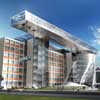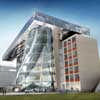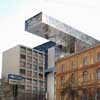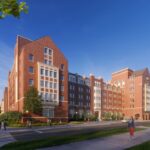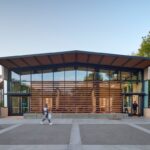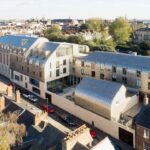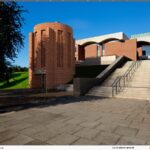Universität für angewandte Kunst, Vienna University building, Austrian architecture design images
University of Applied Arts Vienna, Austria Building
Universität für angewandte Kunst Development design by Wolfgang Tschapeller ZT GmbH
University of Applied Arts, Vienna, Austria
Design: Wolfgang Tschapeller ZT GmbH
Vienna, Austria, 2012
The new University of Applied Arts
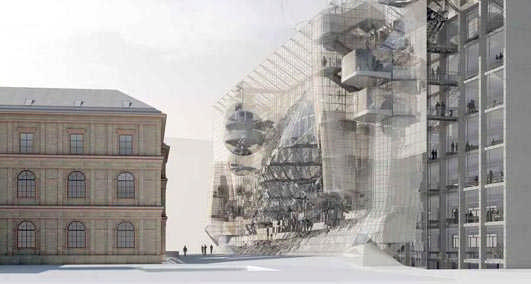
image : Wolfgang Tschapeller ZT GmbH / Isochrom
7 Mar 2012
Universität für angewandte Kunst Wien
6 Points for a NEUE ANGEWANDTE
Between the 1st and 3rd districts in Vienna on the Ringstrasse a few buildings of different authors and times are collected on a block. Heinrich von Ferstel, Schwanzer-Wörle and Noever-Müller are the architects of the group of fine buildings. Some of them serve the purposes of the Museum for Applied Arts and some of them serve the University of Applied Arts. The original urban intent for this group of buildings follows a very fine, subtle and precise idea. Although being part of a block, or standing on a block, they were always meant to keep their independency and autonomy by simultaneously allowing for a visibility of the space in between them.
In late 2011 an international 2 stage competition was announced. Wolfgang Tschapeller ZT GmbH proposed 6 POINTS FOR A “NEUE ANGEWANDTE”

image : Wolfgang Tschapeller ZT GmbH / Isochrom
ERASE – RESTORE
The LINK BUILDING by Schwanzer/Wörle was an unfortunate move. It does not only work strongly against the original urban intent of a loose and open grouping of buildings on a block. It works also against the character of Schwanzer/Wörle´s own design. Ferstel Bau as well as the Schwanzer/Wörle Bau are in their essence autonomous objects standing in critical and productive distance to each other. Such a reading is re-proposed in our project. Consequently the following steps are proposed:
– Demolition link building,
– Reconstruction of those parts of the Ferstel Bau and the Schwanzer-Wörle Bau which were destroyed by the insertion of the LINK BUILDING,
– Activation of the now very well lit areas of the Schwanzer/Wörle Bau
DISLOCATE
We are fascinated by seriality of the Schwanzer/Wörle Bau. The building consists in essence of a series of columns and slabs. By taking out stairs and elevator cores and by repositioning them in front of the serial structure of the Schwanzer/Wörle Bau two essential targets are achieved:
– Full flexibility on the entire floor slab
– Remarkable gain of usable floor area
– Improvement of circulation (in economic and spatial terms)
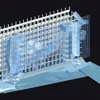
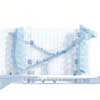

images : Wolfgang Tschapeller ZT GmbH / Isochrom
PURE STRUCTURE – AN ENTIRELY EMTPY SHELF
The removal of stair and elevator cores displays a pure serial structure. What remains are solely col-umns and slabs, ready for multiple functional readings. The shelf like structure will house the Studios.
COMMON BASE
Ferstel Bau and Schwanzer/Wörle Bau are connected by a common functional base, containing lecture halls, workshops, storage spaces, technical installations as well as supply lines and waste management.
CAMPUS – WHERE 17 DIFFERENT STUDIOS MEET
In essence we propose 3 main connecting elements to “make” the new Campus of the Angewandte.
– The INTERIOR SQUARE connects Ferstel Bau with Schwanzer/Wörle Bau,
– The GARDEN connects the buildings of the University with those of the Museum
– The BROADWAY, a large stair which runs diagonally across the elevation of the Schwanzer/Wörle Bau.
The BROADWAY is not only a means of circulation; it is the platform where members and knowledge of the 17 different studios meet. It is the informal marketplace for cross disciplinary pro-jects.
TEMPORARY STRUCTURES
On the roof of the University two optional, temporary structures are proposed. Two pneumatic bal-loons indicate and signal special occasions at the Angewandte to the surrounding City. Raised trans-parent balloons means a special day, like flags on a building.
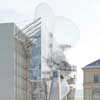

images : Wolfgang Tschapeller ZT GmbH / Isochrom
DIE NEUE ANGEWANDTE
Project: University for Applied Arts, Vienna : international Competition – 1 st Prize
Author: Wolfgang Tschapeller ZT GmbH, Lindengasse 38/6, 1070 Wien
Project Team:
Jesper Bork, Simon Oberhammer, Mark Balzar, Franz Kropatschek, Gonzalo Vaillo Martinez, Daniel Erl
Experts:
Werkraum Wien, Tragwerk
Planungsgruppe Grünpichler GmbH, TGA
Dr. Jochen Käferhaus, Energie + Klimadesign
Brandrat, Brandschutz
Klaus Pokorny, Lichtplanung
ISOCHROM, Armin Hess, Renderings
Universität für angewandte Kunst Wien images / information from Wolfgang Tschapeller ZT GmbH
23 Feb 2012
Universität für angewandte Kunst Wien, Österreich
University of Applied Arts, Vienna, Austria
Design: COOP HIMMELB(L)AU
English text (scroll down for German):
Competition entry COOP HIMMELB(L)AU : The new University of Applied Arts
Vienna, Austria, 2012
Wolf D. Prix:
The new University of Applied Arts
They are not quite my favourites, yet they exemplify the state of mind reflected by the 19th century cultural and educational buildings in Vienna – the University of Applied Arts, the MAK (Museum for Applied Arts), the University, the State Opera and the Burgtheater – self-confident buildings that proclaim the new social role of the middle class.
Insignificant, nondescript buildings – “basement buildings” – are today, more than ever, a waste of money. This is especially true of arts and culture buildings, because they are an external representation of their role as laboratories for new social developments: buildings that capture the spirit of the times with a future-oriented aesthetic that serve as three-dimensional platforms for research and experiments. Visual network buildings, you might call them.
The concepts on which the submitted project draft is based are derived from such considerations, from the functional and economic parameters, the specific situation which needs to be taken into account, and the resulting administrative requirements (Office for Historical Monuments, MA 19, MA21).
We do not consider our project to be an annex or an ancillary building. In conjunction with the two existing buildings (Ferstel Wing, Schwanzer Wing), it is rather a third building, which forms a single urban space requiring restructuring.
The Campus Concept
Due to the spacing of the connecting passages, the individual existing structures are designed as stand-alone features. The entire area is publicly accessible: a passage between the Stubenring and the Wotruba Promenade is created by opening up three axes on the first floor of the Schwanzer Wing. It seeks to integrate the MAK courtyard and an existing ramp into the public open space. The new, central entrance is situated within a cone-shaped building element at the intersection of the three courtyards.
The Loft Concept
Removal of obsolete access cores and sanitary facilities from the Schwanzer Wing creates new loft spaces that can be freely divided into flexible segments across the entire floor. As a result, the usable floor area in the Schwanzer Wing is expanded. Modern access cores will be erected in the courtyard in front of the Schwanzer Wing.
The Flying Roof Concept
The project is significant from an urban design perspective because of the creation of generous usable floor space on the top floor. There will be no large-scale construction works on the courtyard side of Schwanzer Wing, leaving intact the protected historical appearance and the courtyard façade. The courtyards are mostly preserved.
The Lighting Concept
Natural lighting, in accordance with Viennese building regulations and Guideline 3 of the OIB (Austrian Institute of Construction Engineering), for the recreational rooms in the Ferstel Wing is provided by the twisted light prism, which is inserted through a corresponding incision in the top floor.
Allocation of Functions
The individual functions are clearly assigned to certain spaces: administration (in the Ferstel Wing), education (in the cone) and the studios (in the Schwanzer Wing). The entrance lobby on the first floor of the cone is directly linked to the exhibition and event space on the first floor of the Schwanzer Wing and the lecture halls and seminar rooms in the basement.
These spaces are accessible from the entrance hall by wide staircases. The event space is serviced by the restaurant located on the ground floor of the Schwanzer Wing. The restaurant, which also has a separate entrance to the courtyard, is operated as an independent catering business.
Universität für angewandte Kunst – conceptual movie:
Die neue Angewandte Film on YouTube
German text:
Erweiterung Universität für angewandte Kunst, Vienna, Austria, 2012
Wolf D. Prix
Die neue Angewandte
Es sind nicht gerade meine Lieblinge, aber man sollte sich die Haltung, die hinter den Kultur- und Bildungsbauten des 19. Jahrhunderts in Wien zu finden ist, wie etwa die Universität für angewandte Kunst, das MAK (Museum für Angewandte Kunst), die Universität, die Staatsoper und das Burgtheater, einmal als Beispiele ansehen. Als selbstbewusste Gebäude, die neue gesellschaftliche Rolle des Bürgertums definierend, treten sie auf.
Unscheinbare, nichtssagende Gebäude, sogenannte Kellergebäude, sind heute – gerade heute mehr denn je – Geldverschwendung. Das trifft in besonderem Maße für Kunst- und Kulturbauten zu, denn sie haben ihre Rolle als Labor für neue gesellschaftliche Entwicklungen auch nach außen darzustellen: als Gebäude zeitrichtiger, also vorausblickender Ästhetik, die dreidimensionale Plattformen für Forschung, Experiment sind. Man kann sie als visuelle Netzwerkgebäude beschreiben.
Diese Überlegungen, die funktionellen und ökonomischen Rahmenbedingungen sowie die zu berücksichtigende spezielle Situation und die sich daraus ergebenden Forderungen der Beamtenschaft (Denkmalamt, MA 19, MA 21) führten uns zu den Konzepten, die den vorliegenden Entwurf ergeben.
Allerdings sehen wir unser Projekt weder als Anbau noch als Zubau sondern als drittes Gebäude, das zusammen mit den beiden bestehenden (Fersteltrakt, Schwanzertrakt) ein Ensemble bildet, welches eine stadträumliche Neuorganisation erfordert.
Das Campuskonzept
Durch die Entfernung der Verbindungstrakte werden die einzelnen Bestandsgebäude freigestellt. Das gesamte Areal wird öffentlich zugänglich gemacht: eine Passage zwischen Stubenring und der Wotruba-Promenade wird durch die Öffnung von drei Achsen im Erdgeschoß des Schwanzertraktes geschaffen. Die Integration des MAK-Hofes und der Noever-Rampe in das öffentliche Freiraumkonzept wird angestrebt. Der neue, zentrale Haupteingang liegt am Schnittpunkt der drei Höfe im Kegel.
Das Loftkonzept
Durch das Entfernen der veralteten Erschließungskerne und Sanitärräume aus dem Schwanzertrakt entstehen im gesamten Geschoß frei einteilbare und flexible Loftflächen und dadurch eine Vergrößerung der Nutzfläche im Schwanzertrakt. Zeitgemäße Erschließungskerne werden hofseitig vor den Schwanzertrakt gestellt.
Das Flying Roof Konzept
Die städtebauliche Signifikanz des Projektes entsteht durch die Schaffung von großzügigen Nutzflächen im Dachgeschoß. Eine großflächige, hofseitige Verbauung des Schwanzertrakts wird vermieden und somit der Erhalt des denkmalgeschützten Erscheinungsbildes und der Hoffassade gewährleistet. Die Hofflächen werden weitestgehend erhalten.
Das Belichtungskonzept
Die Belichtung der Fenster von Aufenthaltsräumen im Fersteltrakt wird nach Maßgabe des verschwenkten Lichtprismas nach Wiener Bauordnung und OIB Richtlinie 3 durch einen entsprechenden Einschnitt in das Dachgeschoß erreicht.
Die Funktionsverteilung
Die einzelnen Funktionen haben klare räumliche Zuordnungen. Die Verwaltung (im Fersteltrakt), die Lehre (im Kegel) und die Studios (im Schwanzertrakt). Die Eingangslobby im Erdgeschoss des Kegels ist direkt mit der erdgeschoßigen Veranstaltungszone im Schwanzertrakt und den Vorlesungs- und Seminarräumen im Untergeschoss verbunden.
Erschlossen werden die Zonen über eine großzügige Freitreppe aus dem Foyer. Die Andienbarkeit der Veranstaltungszone erfolgt von der Mensa im Erdgeschoss des Schwanzertrakts. Die Mensa, über einen Eingang im Hof auch separat zugänglich, funktioniert als eigenständiger gastronomischer Betrieb.
University of Applied Arts Vienna – Building Information
TEAM
Planning: COOP HIMMELB(L)AU
Wolf D. Prix & Partner ZT GmbH
Principal in Charge: Wolf D. Prix
Design Partner: Karolin Schmidbaur
Project Partner: Helmut Holleis
Project Architect: Friedrich Hähle
Design Architect: Jan Brosch
Project Team: Laura Ghitta, Tom Hindelang, Daniela Kröhnert, Heimo Math, Daniel Moral, Martin Mostböck, Andrea Müllner, Arndt Prager, Anja Sorger
Model Building: Paul Hoszowski, Sebastian Buchta
3D Visualization: Steven Ma, Cynthia Sanchez Morales
Client: BIG Bundesimmobiliengesellschaft Wien
Photography: Markus Pillhofer
CHRONOLOGY
Competition: 2012
PROJECT DATA
Site Area: 7.060m²
Total usable Floor Area: 22.600m²
Existing Building (renovated) Usable Floor Area: 16.500 m²
Extension (new construction) Usable Floor Area: 6.100 m²
Building Height: 34.85 meters
Building Costs: EUR 46 Mio
University of Applied Arts Vienna MAK images / information from COOP HIMMELB(L)AU
Location: Vienna, Austria
New Vienna Architecture
Contemporary Viennese Architecture
Vienna Architecture Design – chronological list
Vienna Architecture Tours by e-architect
Telegraf 7 Building, Lehargasse
Design: BEHF Architects
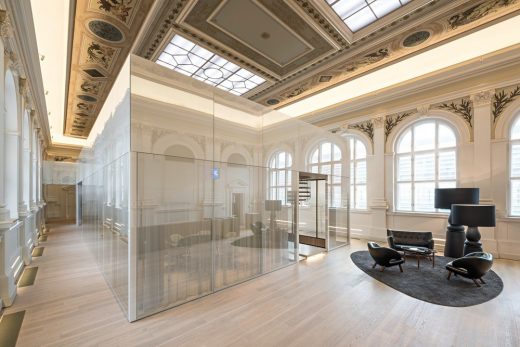
photograph : Hertha Hurnaus
Telegraf 7 Building in Vienna
Vienna University Buildings
University of Economics & Business : Library and Learning Centre
Zaha Hadid Architects
University of Economics & Business Vienna : design competition win
University of Economics & Business Vienna : Spain Department Building
Estudio Carme Pinós
University of Economics & Business Vienna Building
The University of Economics Vienna : The Wirtschaftsuniversität
flatzarchitects
Wirtschaftsuniversität
Comments / photos for the University of Applied Arts Vienna MAK – Universität für angewandte Kunst Wien page welcome

